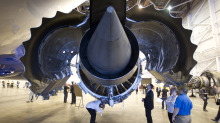Small firm keen to soar by cutting jet engine fuel consumption
 A non-stick nanotechnology coating developed in Ontario is promising to reduce the fuel consumption of jet engines, making them a little more environmentally friendly.
A non-stick nanotechnology coating developed in Ontario is promising to reduce the fuel consumption of jet engines, making them a little more environmentally friendly.EnvAerospace Inc. of Brampton expects to bring the product to market later this year after more than a decade in development, company president and CEO Jonathan Webster said.
“The technology is applicable across different industries but we’ve chosen to focus entirely on aerospace for the time being,” Mr. Webster said.
The company uses a process called physical vapour deposition to apply nanomaterials to metal surfaces, such as the turbine blades deep inside jet engines. The latest iteration applies implanted metallic oxides, a process for which the company has a patent application pending in the United States, said Mariusz Warzyszynski, the company’s vice-president of engineering.
He declined to be more specific about the material because of its proprietary nature.
“This process is not so simple, so it’s not exactly Teflon coating,” said Mr. Warzyszynski, who has been working on it since 1998. He described a complex process where plasma is formed in baffled chambers en route to being applied to a material, such as a turbine blade.
Founded in 2010, EnvAerospace grew out of an earlier company, GTF Aerospace, which dates back to 2001. Originally, the technology was aimed at military applications. However, shortly after Mr. Webster joined in 2009, the company decided on a new focus.
“We essentially positioned the company as an environmental play going forward,” Mr. Webster said. While the company is still in the “pre-revenue phase,” he is optimistic that the product will go to market by the end of the third quarter this year.
Aside from protecting jet engine parts from sand, grit and burnt fuel, the coating also enables an engine to burn 1 to 2 per cent less fuel, Mr. Webster said. That can amount to 1,000 kilograms of fuel savings, or more, on the flight of a wide-bodied jet from Toronto to Tokyo, for example, he added.
“That fuel saving is now potentially a carbon credit,” said Mr. Webster, who is also a Boeing 777 pilot for Air Canada. “And when you look at an airline as a net carbon emitter, they are looking for opportunities to save.”
Now his next task is to convince jet engine manufacturers and the airlines that EnvAerospace performs as promised and is worth the investment.
General Electric is considering conducting tests of the EnvAerospace coatings “to see if we can substantiate this for use in our engines,” said Dan O’Reilly, business program manager at GE’s Repair Technology Centre of Excellence in Cincinnati, Ohio.
“We as a company are very interested in new compressor airfoil coating technologies to enhance our erosion capability,” Mr. O’Reilly added.
Going back to the 1980s, GE has introduced various airfoil coatings, from tungsten carbide to titanium nitride, but is constantly looking at new opportunities. GE’s primary aim for the coatings has not been to improve aerodynamic efficiency or specific fuel consumption. However, that is something Mr. O’Reilly would like to test with the EnvAerospace technology.
“And what John has told me about has been very intriguing from capturing some of the limitations we have with these other coatings,” Mr. O’Reilly said.
Mr. Webster has also briefed Dave Legge, Air Canada’s senior vice-president of operations, on the technology.
“It sounds like it’s a good product,” said Mr. Legge, who is also an Air Canada pilot and has known Mr. Webster for about 10 years. “One of the issues would be, and I’m not too sure of the cost, if we are leasing an engine we’d be spending a lot of money on that engine that would eventually would be returned to the owner at some point.”
But Mr. Legge said he is no expert on such matters and has arranged for Claude St. Martin, Air Canada’s director of fuel efficiency, to meet with Mr. Webster to learn more about EnvAerospace’s coating technology. That meeting had not yet taken place by press time.
“I still don’t have much of an opinion because we want to investigate it properly and not discount something that could be of significant value,” Mr. St. Martin said. “Our first impression is that coatings in Canada might not be as beneficial as in other parts of the world where you can have a little more abrasive type of environment [such as in the desert].”
To date, EnvAerospace and its predecessor have invested about $15-million in the technology. Most of that money has come from company chairman Sidney Harkema, the founder and former owner of Harkema Trucking Group. Mr. Webster, EnvAerospace’s co-owner, is providing sweat equity while continuing to fly jets for a living.
So far, he and Mr. Warzyszynski are the only two employees, although they have a team ready to begin working as soon as customers come calling. The 800-square-metre facility in Brampton has two nanoparticle source machines, resembling a pair of 1960s mainframe computers, to perform the physical vapour deposition.
“Why we’ve kept it very lean at the moment is because we have the ability to set up a machine on a site that would, let’s say, be an engine manufacturing facility in an OEM (original equipment manufacturer),” Mr. Webster said. “So if we were asked to team up on a venture with GE for example, it’s quite likely GE would want to have a machine down there.”
You can return to the main Market News page, or press the Back button on your browser.

